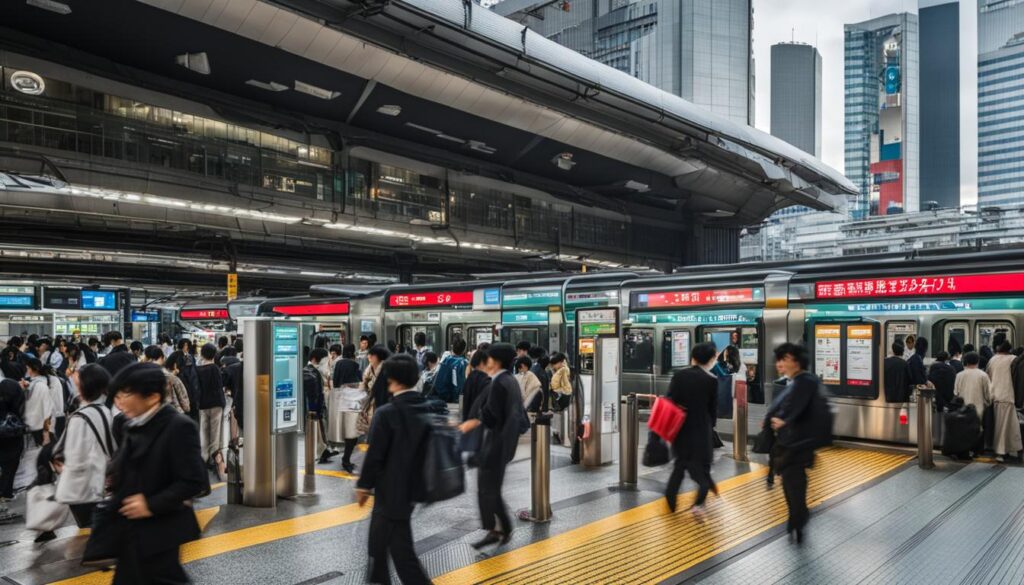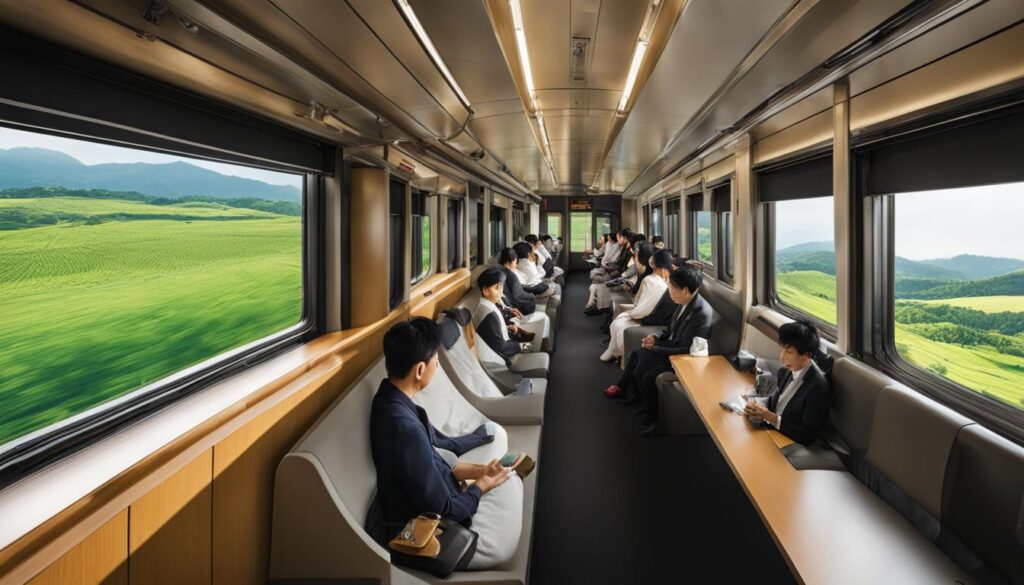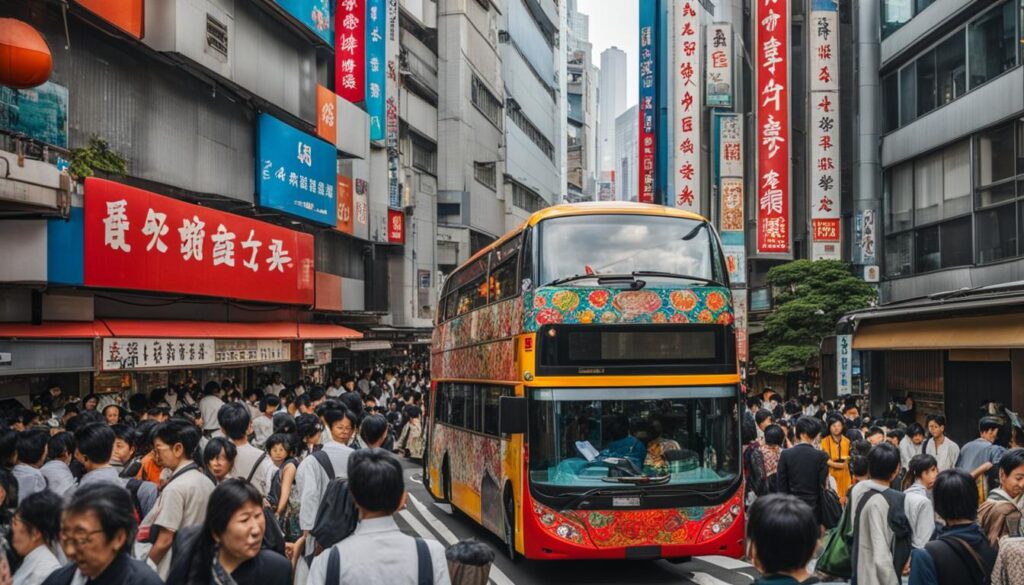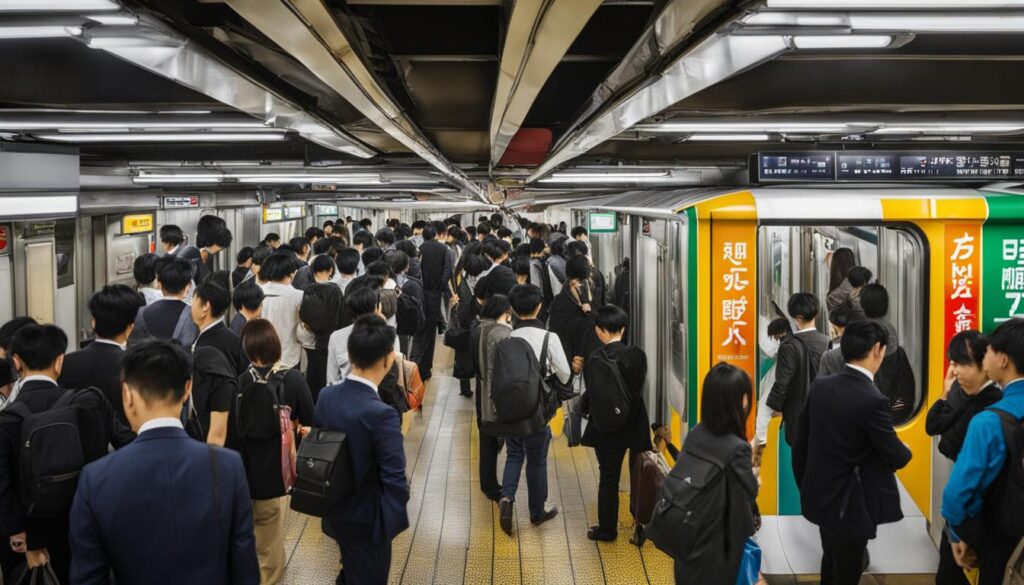If you’re planning a trip to Japan, one of the key questions on your mind is likely: How to get around Japan? Fortunately, Japan boasts an efficient and interconnected transportation system that makes traveling around the country a breeze. In this section, we will provide you with expert tips and advice on how to navigate Japan’s transportation system seamlessly, ensuring that you can make the most of your travel experience.
From trains and buses to subways and rental cars, we’ll explore the various modes of transportation available to you, and provide insights on how to best utilize each option. Whether you’re traveling to major cities or exploring the countryside, our guide will equip you with the knowledge required to travel Japan with confidence and ease.
So, if you’re ready to discover the ins and outs of transportation in Japan, let’s get started!
Understanding Japan’s Transportation System
Japan boasts one of the world’s most efficient and well-connected transportation systems, offering a range of options to get you from point A to point B. Whether you’re traveling within cities or exploring rural areas, understanding Japan’s transportation system is crucial for a smooth and enjoyable travel experience. In this section, we’ll dive into the ins and outs of the Japanese transportation system and provide you with a comprehensive guide for navigating through it.
Types of Transportation in Japan
Japan’s transportation network includes trains, buses, subways, and taxis. Each mode of transportation has its advantages and disadvantages, and the optimal choice for you may depend on your itinerary, budget, and personal preferences.
Trains are a popular option for long-distance travel, while buses are more convenient for shorter distances and sightseeing in rural areas. Subways are ideal for getting around urban centers, and taxis provide a comfortable and convenient option for getting to your destination.
Train System in Japan
The train system in Japan is renowned for its efficiency, punctuality, and speed. The Shinkansen, also known as the bullet train, is a high-speed train that connects major cities in Japan. It can reach speeds of up to 200 miles per hour, making it an excellent option for long-distance travel.
To ride the train in Japan, you’ll need to purchase a ticket or use a prepaid IC card, such as Suica or PASMO. Trains run frequently and are generally on time, so it’s important to arrive at the station early to avoid missing your train.
| Pros | Cons |
|---|---|
| Efficient | Expensive |
| Fast | May be crowded during rush hour |
| Covers large distances | May require transfers |
Bus System in Japan
Buses are another convenient mode of transportation in Japan, especially for exploring rural areas and visiting tourist attractions off the beaten path. There are several types of bus services available, including local buses and long-distance highway buses.
To ride the bus in Japan, you’ll need to purchase a ticket or use a prepaid IC card. Buses may take longer than trains, but they can provide a more scenic experience.
| Pros | Cons |
|---|---|
| Cheaper than trains | May be slower than trains |
| Can access remote areas | Less frequent than trains |
| Scenic views | May not have English signage |
Subway System in Japan
Japan’s subway systems are highly efficient and offer a convenient way to travel within cities. They are often the best option for avoiding traffic congestion and getting around urban areas quickly.
To ride the subway in Japan, you’ll need to purchase a ticket or use a prepaid IC card. Subways can get crowded during rush hour, so it’s important to plan accordingly.
| Pros | Cons |
|---|---|
| Efficient | May be crowded during rush hour |
| Covers urban areas | May require transfers |
| Avoids traffic congestion | May not have English signage |
That covers the basics of transportation in Japan. In the following sections, we’ll provide you with more detailed information about each type of transportation and how to use them effectively.
Getting Around Japan by Train
Japan’s train system is one of the most efficient and well-connected in the world, making it the ideal mode of transportation for travelers looking to explore the country. There are several types of trains available in Japan, including local, express, and bullet trains.
Shinkansen (Bullet Train)
The Shinkansen is Japan’s world-famous high-speed bullet train, and it’s a must-try experience for any visitor to the country. These trains can reach speeds of up to 186 mph (300 km/h) and can take you quickly and comfortably to major cities across the country.
To ride the Shinkansen, you must purchase a ticket in advance. You can buy tickets at the train station or online through the JR Group’s website or other travel agencies. It’s recommended to reserve your seat in advance, especially during peak travel seasons.
Local Trains
Local trains are a budget-friendly option for getting around Japan, particularly for short distances within cities. These trains stop at every station along the line and can be slower than express trains, but they offer a more authentic and immersive experience of traveling like a local.
Express Trains
Express trains are a faster and more comfortable option for traveling longer distances within Japan. These trains make fewer stops than local trains and offer both reserved and non-reserved seating options. If you choose a non-reserved seat, be sure to arrive early to secure a spot.
Train Stations in Japan
Japan’s train stations can be quite large and overwhelming, especially in major cities like Tokyo and Osaka. However, with a bit of preparation, navigating these stations can be quite easy.
Most train stations have signs and announcements in both Japanese and English, and station maps are typically available at the information desk. Additionally, there are often helpful station attendants who can assist with directions and other inquiries.
“Japan’s train system is renowned for its punctuality, cleanliness, and efficiency. Be sure to take advantage of this fantastic mode of transportation during your visit!”
In conclusion, Japan’s train system is an excellent way to get around the country, offering convenience, comfort, and speed. Whether you’re traveling locally or long-distance, by choosing the right type of train and planning ahead, you can maximize your travel experience and see all the wonders that Japan has to offer.
Exploring Japan by Bus
Japan’s bus system is an efficient and affordable way to travel around the country, especially for those looking to explore rural areas or visit tourist attractions off the beaten path.
Local Buses
Local buses operate within a city or prefecture and are an excellent option for short distances. They’re a cheap and reliable mode of transportation and a good way to explore local culture. Fares for local buses usually start at around 200 yen, and the buses make frequent stops throughout the city.
Long-Distance Buses
Long-distance buses are a convenient option for traveling between major cities in Japan. These buses are equipped with comfortable seats and amenities, making them a popular choice for overnight trips. They’re also typically more affordable than train travel, with fares starting at around 4,000 yen.
If you’re planning to take a long-distance bus, it’s recommended to book your tickets in advance, especially during peak travel seasons. You can purchase tickets online or at bus terminals.
Highway Buses
Highway buses are a type of long-distance bus that operates on expressways and highways, allowing for faster travel times between cities. They usually have fewer stops than regular long-distance buses, making them a good option for those looking to get to their destination quickly.
Most highway buses in Japan have amenities such as comfortable seats, toilets, and Wi-Fi. Fares for highway buses are typically higher than regular long-distance buses, starting at around 5,000 yen.
Bus Passes
If you plan to use the bus extensively during your travels in Japan, consider purchasing a bus pass. These passes offer unlimited travel on local and long-distance buses within a specific area or region.
For example, the Hokkaido Bus Pass allows unlimited travel on local and highway buses in Hokkaido for three or five days. The Willer Express Japan Bus Pass offers unlimited travel on Willer Express buses throughout the country for three, five, seven, or ten days.
Bus Stations
Bus stations in Japan are typically well-organized and easy to navigate. Most bus stations have signs and announcements in English, and staff can usually speak some English as well.
At bus stations, look for the departure and arrival signs to find your bus. Make sure to arrive at the bus station at least 10-15 minutes before departure time to allow for any potential delays or last-minute changes.
With its reliable and affordable bus system, exploring Japan by bus is a great way to experience the country’s beauty and culture. Whether you’re traveling on a budget or just looking for a convenient way to get around, buses are an excellent option for your travels in Japan.
Getting Around Japan by Subway: Your Ultimate Guide
Japan’s subway system is one of the most efficient and convenient ways to get around in urban areas. With a network of interconnected lines that can take you almost anywhere in the city, it is no wonder that public transportation in Japan is highly regarded.
If you are planning to get around Japan by subway, here are some tips that can help make your commute more comfortable and stress-free:
Understanding the Subway Map
One of the first things you need to do when getting around Japan by subway is to study the subway map. The map can be overwhelming at first glance, but it’s actually quite simple once you get the hang of it. It’s essential to understand the color-coding, station names, and the different lines to avoid getting lost.
Most subway maps in Japan have an English translation, so you don’t need to worry about language barriers. However, if you are not familiar with the language, it’s best to ask for help from the station attendants or use Google Maps.
Purchasing a Ticket
To enter the subway station, you need to purchase a ticket from the ticket machines. You can select your destination station on the touch screen, and the machine will calculate the fare automatically. You can pay with cash or an IC card, such as Suica or Pasmo.
If you plan to use the subway frequently, it’s recommended to purchase a prepaid card. You can top up the card at ticket machines or convenience stores and use it on the subway, buses, and even vending machines.
Navigating Subway Stations
Subway stations in Japan can be huge, with multiple exits and entrances. It’s essential to plan your route and know which exit to take to reach your destination. Many subway stations have signs and arrows pointing in the right direction, so keep an eye out for them.
If you have heavy luggage, look for elevators or escalators to avoid carrying them up and down stairs. Some stations also have coin lockers where you can store your luggage if needed.
Peak Hours and Etiquette
Peak hours in Japan can be crowded, especially during rush hour. If you want to avoid the crowds, it’s best to travel outside of peak times. However, if you can’t avoid it, be prepared to squeeze in and stand close to other passengers.
Japanese subway etiquette is essential to follow. Be mindful of your surroundings and avoid talking on your phone or using loud music. Don’t eat or drink on the train, and try to keep your belongings close to you to avoid taking up extra space.
“The Japanese subway system is one of the most efficient and punctual in the world. With trains running every few minutes, you will never have to wait long for your next ride.”
Getting around Japan by subway is an excellent way to explore the city and save money on transportation costs. Whether you’re a first-time visitor or a seasoned traveler, following these tips can help make your journey in Japan a smooth and enjoyable one.
Renting a Car in Japan
If you prefer more flexibility and independence during your travels in Japan, renting a car is worth considering. However, note that Japan’s public transportation system is efficient and well-connected, so renting a car should not be your first choice.
The requirements for renting a car include a valid driver’s license, a passport, and a proof of insurance. International driver’s licenses are also accepted, but it is always best to confirm with the car rental company before your trip.
Driving in Japan may be intimidating, especially if you are not familiar with the country’s traffic rules and driving etiquette. Here are a few tips to help you navigate the roads with confidence:
- Drive on the left side of the road: This may seem obvious, but it can be easy to forget if you come from a country that drives on the right side. Keep this in mind when making turns and changing lanes.
- Use ETC (Electronic Toll Collection) for highways: This is a convenient and time-saving way to pay fees on the highways, which can be expensive when using cash. Ask the rental car company about getting an ETC card, which will be linked to your rental car’s license plate.
- Be aware of speed limits and road signs: Speed limits in Japan are in kilometers per hour (km/h), and road signs are in Japanese and English. Familiarize yourself with these before hitting the road.
- Follow driving etiquette: Japanese drivers are known for their courteous and safe driving. Be aware of their habits, such as not honking unnecessarily and using turn signals when changing lanes or making turns.
When deciding whether to rent a car in Japan, consider the pros and cons. Renting a car allows you to explore rural areas and off-the-beaten-path destinations at your own pace. It also provides more storage space for your luggage and allows you to avoid crowded trains and buses during peak hours.
However, keep in mind that driving in urban areas can be challenging, and parking can be expensive and limited. Additionally, toll fees can add up quickly, so factor this into your budget.
“Renting a car in Japan is a great option for exploring the country’s rural areas and hidden gems. However, be prepared for the differences in driving etiquette and traffic rules.”
Utilizing Local Transportation Options
Japan offers a variety of local transportation options that are unique to specific regions. These options can enhance your travel experience and provide an opportunity to explore the local culture. Here are a few examples:
Trams
If you are in Hiroshima, Kagoshima, or Toyama, take a ride on their classic tram systems. These trams are known for their vintage design, comfortable rides, and scenic views. A popular route is the Hiroshima sightseeing loop, which takes you to some of the city’s most iconic landmarks.
Ferries
If you are visiting the islands of Japan, consider taking a ferry ride. It’s an exciting way to explore the stunning scenery and get a glimpse of local life. One popular island-hopping route is between Hiroshima and Miyajima Island. Along the way, you can enjoy breathtaking views of the Seto Inland Sea.
Bikes
If you’re feeling adventurous, renting a bike is a great way to explore Japan’s rural areas. Many cities offer bike rental services, and it’s a fun and eco-friendly way to get around. You can also join a guided bike tour and discover hidden gems that you may have missed otherwise.
These are just a few examples of the local transportation options available in Japan. No matter where you go, there are always unique and exciting ways to get around and experience the local culture.
Planning Your Travel Routes
Planning ahead can save you time, stress, and money when traveling in Japan. Here are some useful tips for planning your travel routes:
- Research your destinations and create a rough itinerary before you go.
- Use online resources, such as Japan Rail Pass or Hyperdia, to check schedules and prices for trains, buses, and subways.
- Consider purchasing a transportation pass or smart card, like the JR Pass or Suica card, to save money and simplify your transportation experience.
- Before boarding a train, bus, or subway, check the route and final destination to avoid getting lost or taking the wrong direction.
- Take into account rush hours and peak travel times when planning your routes, as trains and subways can get very crowded during these times.
- Be flexible and open to changes in your plans, such as weather conditions or unexpected closures or delays.
Example Route Plan
To give you an idea of how to plan your routes, here’s an example itinerary for a week-long trip to Japan:
| Day | Destination | Transportation |
|---|---|---|
| Day 1 | Tokyo | Arrive at Narita Airport, take Narita Express to Tokyo Station, take subway to hotel |
| Day 2 | Tokyo | Explore city by subway and walk |
| Day 3 | Kyoto | Take Shinkansen from Tokyo Station to Kyoto Station, take bus to hotel |
| Day 4 | Kyoto | Explore city by bus and walk |
| Day 5 | Hiroshima | Take Shinkansen from Kyoto Station to Hiroshima Station, take bus to hotel |
| Day 6 | Hiroshima | Explore city by streetcar and walk |
| Day 7 | Tokyo | Take Shinkansen from Hiroshima Station to Tokyo Station, take Narita Express to Narita Airport |
Remember to factor in travel time and transfers when planning your itinerary. This will ensure that you have a stress-free and enjoyable trip to Japan.
Final Thoughts on Getting Around Japan
With so many transportation options available in Japan, it can seem overwhelming to plan your travel routes. However, with the right tools and knowledge, you can seamlessly navigate the country’s transportation system and make the most of your trip.
Plan Your Travel Routes in Advance
Before embarking on your journey, take the time to plan your travel routes in advance. This will help you save time and reduce stress while navigating Japan’s vast transportation network. Consider using websites, apps, or guidebooks to research train schedules, bus routes, and subway maps to help you plan your itinerary more efficiently.
Use Japan’s Exceptional Transportation System
Japan’s transportation system is considered one of the best in the world for a reason. From the efficient bullet trains to the well-connected subway networks, utilizing Japan’s transportation options can help you explore the country with ease. Whether you prefer to ride the bus, take the train, or drive a rental car, be sure to take advantage of Japan’s excellent transportation system.
Take Advantage of Local Transportation Options
When traveling in Japan, be sure to explore local transportation options to enhance your travel experience. From ferries and trams to unique modes of transportation in different regions, these options offer a great opportunity to experience Japan’s culture and history.
Make the Most of Your Travel Experience
By following the tips and advice in this guide, you can navigate Japan’s transportation system with confidence and ease. With a little planning and preparation, you can make the most of your travel experience and explore this beautiful country to the fullest.
So pack your bags, grab your Japan Rail Pass, and get ready to embark on an unforgettable adventure. Japan awaits!















































